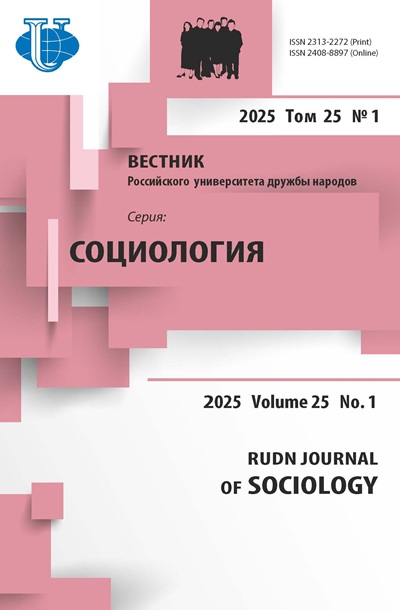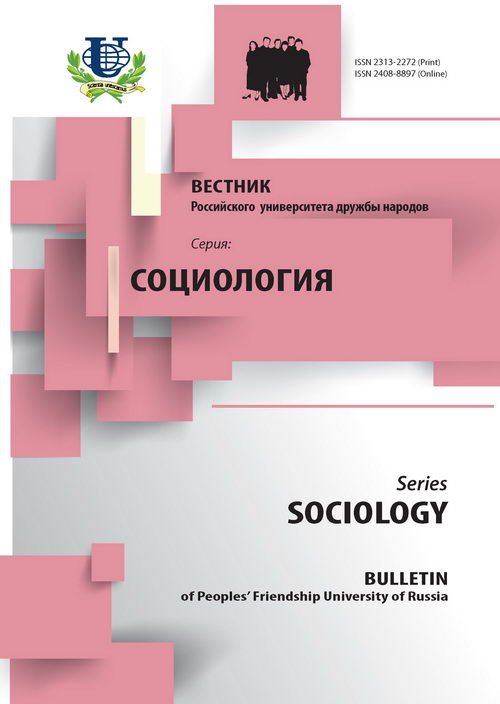Трактовки понятия «безопасность»: международный сопоставительный контекст
- Авторы: Диас Николас Х.1
-
Учреждения:
- Университет Европы в Мадриде
- Выпуск: Том 16, № 2 (2016)
- Страницы: 219-257
- Раздел: Вопросы истории, теории и методологии
- URL: https://journals.rudn.ru/sociology/article/view/6466
Цитировать
Полный текст
Аннотация
Автор рассматривает безопасность как ключевую ценность для всех современных типов обществ, что объясняется радикальным изменением ценностной системы с конца ХХ в., суть которой состоит в определенном возрождении материалистических ценностей и снижении уровня личной и экономической безопасности под воздействием глобализации. В статье представлены две различные, но взаимодополняющие концептуальные модели социологического анализа проблем безопасности. Первая оформилась в конце 1970-х гг. в ответ на чрезмерный социальный оптимизм, порожденный высоким уровнем и темпами экономического развития в предыдущие десятилетия. В рамках этой модели автор группирует 59 стран в семь геокультурных мировых регионов, где ценностные изменения состояли не только в сокращении постматериалистических предпочтений, но и в возрастании заинтересованности в большем социальном контроле, особенно в развитых странах. Вторая концептуальная модель определяет все формы социальной организации (политические, экономические, семейные, образовательные и пр.), включая ценностные системы как инструменты адаптации общества к своему окружению. Соответственно, здесь основная гипотеза состоит в том, что ценности меняются под влиянием уровня безопасности - и личной, и экономической - и в случае его возрастания, и в ситуации его падения. Автор рассматривает на теоретическом и эмпирическом уровнях четыре индекса безопасности - личный, групповой, государственный и глобальный. Согласно результатам европейских опросов общественного мнения, развитые страны чувствуют себя в большей субъективной безопасности, чем развивающиеся страны, однако даже внутри каждого геокультурного региона наблюдаются серьезные различия. На базе трех групп переменных, объединенных в четыре индекса безопасности (социально-демографические, установочные, госбезопасности и комбинации всех трех), автор показывает, что наибольшим объяснительным потенциалом по отношению ко всем четырем индексам безопасности обладает комбинированный набор переменных. Однако следует помнить о серьезных различиях четырех типов безопасности - как между семью геокультурными регионами, так и между странами внутри каждого из них. Это означает, что именно страна/государство остается наиболее важной единицей анализа в любых межстрановых сопоставлениях, которые, в свою очередь, должны основываться и на субъективном, и на объективном измерениях безопасности.
Об авторах
Хуан Диас Николас
Университет Европы в Мадриде
Автор, ответственный за переписку.
Email: 100613.2721@compuserve.com
Список литературы
- Alkire S. (2003) A Conceptual Framework for Human Security. Working Paper 2. Centre for Research on Inequality, Human Security and Ethnicity, CRISE. Queen Elizabeth House, University of Oxford.
- Arriagada I., Godoy L. (1999) Seguridad ciudadana y violencia en América Latina: diagnóstico y políticas en los años noventa. CEPAL, United Nations. Santiado de Chile.
- Bigo D. (2000) When Two Become One: Internal and External Securisitations in Europe. In M. Kelstrup, M. Williams. International Relations Theory and the Politics of European Integration. Power, Security and Community. London: Routledge.
- Bilgin P. (2003) Individual and societal dimensions of security. International Studies Review. Vol. 5.
- Bosch J.L.C., Farras J., Martin M., Sabate J., Torrente D. (2004) Estado, mercado y seguridad ciudadana: Análisis de la articulación entre la seguridad pública y privada en España. Revista Internacional de Sociología. Vol. 39.
- Butterfield H. (1951) History and Human Relations. London: Collins.
- Brimmer E. (ed.) (2008) Five Dimensions of Homeland and International Security. Center for Transatlantic Relations, The John Hopkins University.
- Dahrendorf R. (1959) Class and Class Conflict in Modern Society. Stanford: Stanford University Press.
- Davis K. (1949) Human Society. London: McMillan.
- Díez-Nicolás J. (1980) La España previsible" (Forecast of Spain). Revista Española de Investigaciones Sociológicas. Vol. 12.
- Díez-Nicolás J. (2009) Cultural differences on values about conflict, war and peace. In Y. Esmer, H.-D. Klingemann, B. Puranen (eds.) Religion, Democratic Values and Political Conflict. Festschrift in Honor of Thorleif Pettersson. World Values Survey. Uppsala University.
- Díez-Nicolás J. (2009) Some theoretical and methodological applications of centre-periphery theory and the social position index. In K. van der Veer, A. Hartmannn, H. van den Berg (eds.), J. Díez-Nicolás, J. Galtung, H. Wiberg. Multidimensional Social Science. Rozenberg, Amsterdam.
- Díez-Nicolás J. (2010) Poder político y poder financiero (Political Power and Financial Power). Tercera, ABC, 30 August.
- Díez-Nicolás J. (2011) ¿Regreso a los valores materialistas? El dilema entre seguridad y libertad en los países desarrollados (Return to materialist values? The dilemma between security and freedom in developed countries). Revista Española de Sociología. Vol. 15.
- Díez-Nicolás J. (2011) La Seguridad subjetiva en España: Construcción de un índice sintético de seguridad subjetiva (ISSS) (Subjective Security in Spain: Construction of a Synthetic Index of Subjective Security). Madrid: Ministerio de Defensa.
- Díez-Nicolás J. (2013) Desequilibrios demográficos (Demographic imbalances). In Instituto Español de Estudios Estratégicos, Los potenciadores del riesgo (Risk Enhancers). Madrid: CESEDEN, Ministerio de Defensa.
- Díez-Nicolás J. (2013) ¿Crisis económica, crisis financiera o crisis del sistema social global? (Economic crisis, financial crisis, or crisis of the global social system?). Revista Española de Sociología. Vol.19. FES, Madrid.
- Díez-Nicolás J. (2013) Measuring the Concept of Security in a Comparative Perspective. Social and Economic Survey Research Institute (SESRI)-World Values Survey-Arab Barometer-Qatar University, Doha.
- Díez-Nicolás J. (2014) La globalización y las crisis (Globalization and Crisis). Tercera, ABC, 11 April.
- Fuentes C.F., Basombrio C.I., Dellasoppa E.E., Frühling H.E. (2011) Seguridad ciudadana en América Latina. Instituto de Asuntos Públicos. Santiago de Chile.
- Galtung J. (1964) Foreign policy opinion as a function of social position. Journal of Peace Research. Vol. 34.
- Galtung J. (1969) Violence, peace, and peace research. Journal of Peace Research. Vol. 6.
- Galtung J. (1976) Social position and the image of the future. In H. Ornauer et al. (eds.) Images of the World in the year 2000. Paris: Mouton.
- Galtung J. (1996) Peace by Peaceful Means: Peace and Conflict, Development and Civilization. London: Sage.
- Haerpfer C., Wallace C. (1997) Internal and external security in post-communist Eastern Europe. Results of a 10-nation study. Institute for Advanced Studies. Wien, Sociological Series. No. 20.
- Haerpfer C., Wallace C., Rose R. (1997) Public perceptions of threats to security in post-communist Europe. Studies in Public Policy. No.293. University of Strathclyde, Glasgow.
- Haerpfer C., Milosinksi C., Wallace C. (1999) Old and new security issues in post-communist Eastern Europe: Results of an 11 nation study. Europe-Asia Studies. Vol. 51. No. 6.
- Halle N.H. (1966) Social position and foreign policy attitudes. Journal of Peace Research. Vol. 1.
- Hawley A.H. (1950) Human Ecology. New York: The Ronald Press Company.
- Hawley A.H. (1962) La Estructura de los sistemas sociales (Structure of Social Systems). Madrid: Tecnos.
- Herz J. (1951) Political Realism and Political Idealism: A Study in Theories and Realities. Chicago: Chicago University Press.
- Ilie F.A. (2012) National and international security objectives: some correlations. Journal of Defense Resources Management. Vol. 3. Issue 1.
- Inglehart R. (1977) The Silent Revolution. Princeton: Princeton University Press.
- Inglehart R. (1990) Culture Shift in Advanced Industrial Society. Princeton: Princeton University Press.
- Inglehart R. (1997) Modernization and Post-Modernization. Princeton: Princeton University Press.
- Jarvis R. (1976) Perception and Misperception in International Politics. Princeton: Princeton University Press.
- Jarvis R. (1978) Cooperation under the security dilemma. World Politics. Vol. 30. No. 2.
- Meadows D.H. et al. (1972) The Limits to Growth. New York: Universe Book.
- Medina J. (2003) Inseguridad ciudadana, miedo al. delito y policía en España. Revista Electrónica de Ciencia Penal y Criminología.
- Newman E. (2010) Critical human security studies. Review of International Studies. Vol. 36.
- Nieto Huertas L. (2003) El estado del arte de la seguridad urbana. Circunstancia. Vol. I. No. 2. Septiembre 1-21.
- Posen B.R. (2006) European Union security and defence policy: Response to unipolarity? Security Studies. Vol. 15. No. 2.
- Rowley C., Weldes J. (2011) The evolution of international security studies and the everyday: Suggestions from the buffyverse. School of Sociology, Politics and International Studies, Working Paper 11-12. University of Bristol.
- Tang S. (2009) The security dilemma: a conceptual analysis. Security Studies. Vol. 18. No. 3.
- Unites Nations (1994) New Dimensions of Human Security. Chapter 2. Human Development Report 1994.














